Bike stuff
1. One of the most interesting and unexpected announcements this week is that the DC Metrorail system is lifting its ban on bicycles during rush periods ("Metro to welcome bicycles on trains at rush hour starting Jan. 7," WJLA-TV). (In 2001 I think, was one of the first people to use Metrorail the day that you no longer had to have a "pass," being stopped by many personnel that day and me alerting them to the new policy.) It takes effect next week.)
I understood the ban, at least going in to the city, because many trains are packed.
That they changed this policy is likely in response to significant drops in ridership.
2. In the design of the next series of train cars, Metrorail should include specific accommodations for bicycles such as hooks and other mechanisms, to better "wrangle" bikes so that they don't hinder passenger movement in and out of cars.
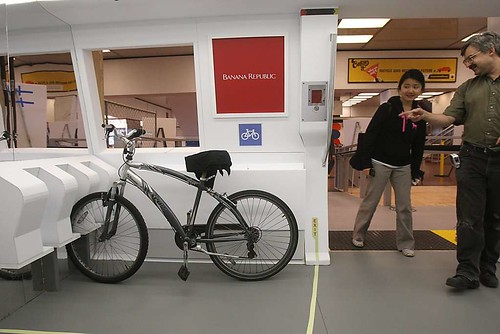
Photograph: Liz Hafalia, San Francisco Chronicle. Contractor Brian Liebowitz (far right) shows a commuter the bike rack for the "Fleet of the Future" model train car at a media preview at MacArthur Bart station in Oakland, Calif., on Monday, July 22, 2013. The preview of Bart's "Fleet of the Future" model train car will be open for public viewing from Tuesday to Friday.
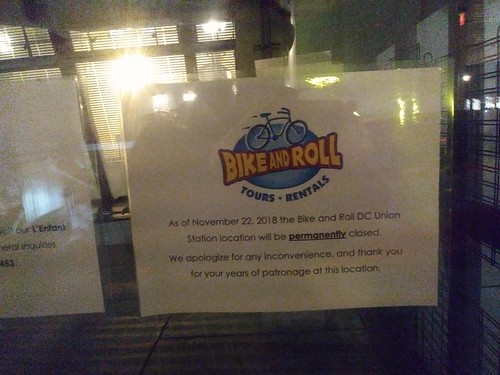
3. I didn't realize that Bike and Roll, the operator of the Bike Station at Union Station, left the facility in late November. The separate Bike Station provides secure parking and was intended for use by rail commuters at Union Station, with the idea that they would get to their final destination by bike.
In reality, most of the railroad commuters seem to prefer the subway. Bike and Roll used the site for bike rental, but this business is probably losing out to bike share and other micromobility options.
4. In my comments on various iterations of planning for the next generation Union Station, I've made the point that DC Union Station could be made into the nation's premier example of multi-modal accommodation, especially for bikes, especially because the station is owned by the US Department of Transportation.
While train stations in the Netherlands, Denmark, and Japan are probably the best in the world, in the UK, Network Rail has been expanding their focus on bikes, putting hubs in at many stations. For example, the train station in Cambridge has parking for 3,000 bikes.
In Victoria State, Australia, they have a network of bike parking facilities dubbed Parkiteer, where a registered user has access to any of the facilities. (In the summer I came across a handful of protected bike parking hubs in Santa Ana, called Bike Huts, but it is nothing like the Parkiteer system and shows the value of a much broader system.)

The LA Metro system is creating a system of bike hubs too.
They own LA Union Station and have a bike hub adjacent to the station with secure parking, combined with a bike shop run by the Bike Center of Santa Monica. While the SM center has showers, lockers, and towel service, it is independent of the LA Metro bike hubs, which do not have those facilities. But it's still a model that more transit systems should consider. Members have access to all of the hubs for secure parking.
-- LA Metro Bike Hubs
Twitter photo by Alaina Harkness.
5. I learned that in Medellin, transit users can use a bike share bike for free for one hour to finish their trip. It's built into their use of transit fare cards ("Integrating Public and Private Mass Transportation," UCB).
For this to work, you'd have to have a public transportation system that is integrated and focused on facilitating the journey at every point, not focused on who offers what service, with prices at every stage.
6. Ten years ago I wrote a piece, "Ideas for Making Cycling Irresistible in Washington, DC" (riffing on the title of a journal article by John Pucher, "Making Cycling Irresistible: Lessons from The Netherlands, Denmark and Germany," Transport Reviews), commissioned by the DC Bicycle Advisory Committee in response to a then initiative by Rails to Trails Conservancy. I focused on urban-focused biking initiatives.
One was that DC should incorporate map signs into the bikeway signage system. I noticed such as sign for the first time on Monday, although it indicates I should have made the point that map signs are needed at two scales, "micro" and "macro". This sign is at the micro scale and the image I used to illustrate the point was at both the micro and macro scale.
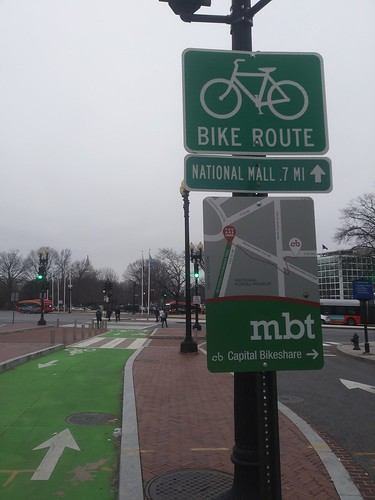
Map sign for the Metropolitan Branch Trail at Union Station, Washington, DC
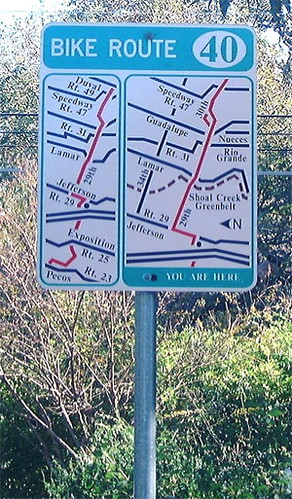
Bicycle Route 40 sign, Austin Texas. Photographer unknown.
7. I missed this Roll Call article from last September, "If Biking In DC Is So Easy, Why Don't More People Do It?" I think that's a great question, although the article doesn't say much.
I'd say that given how the US transportation paradigm is focused on automobile, more effort needs to be made to assist people in making the transition, making it easier to get bikes (e.g., in the UK they have payroll deduction programs to pay for bikes for commuting), making it possible to borrow bikes to test out biking for transportation, like how many communities offer this in the UK, through "Cycle Loan Schemes," etc.
8. I happened to be in Santa Barbara over the holidays and one day I was able to cycle on the Coast Trail up to the UC Santa Barbara Campus and the "campus town" of Isla Vista.
I have never seen so many bike racks on a college campus and in the adjoining town. Both places are nodes in the UCSB Hoppin bike share system. (I haven't been to Eugene, Oregon...)
I bet that the UCSB campus has more bike racks than all of DC's colleges combined. All the UC schools have national best practice programs in transportation demand management with a big focus on bikes. There was an intra-campus bike lane network--mostly as cycletracks--also, which is something that more universities should be doing.

A dormitory?
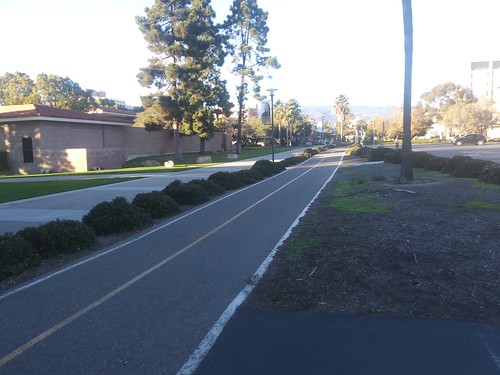
Cycletracks in the center of campus.
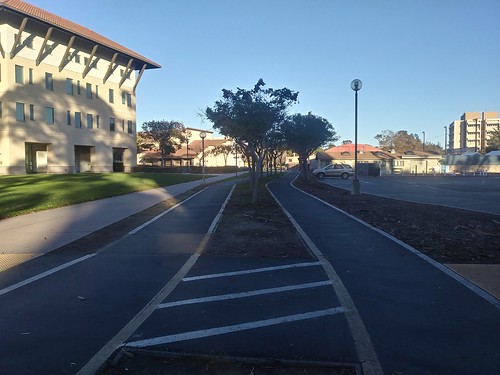
9. Long portions of the Coast Trail, run by the City of Santa Barbara, were lighted. Lack of adequate lighting for night-time riding is a problem with many "shared use paths." Of course, in warmer climes where people are more likely to ride, and all year at that, it makes sense they would be focused on accommodating night-time cycling.
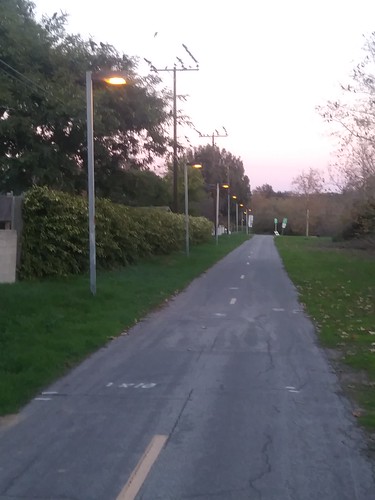
10. Bike gutters, or glide tracks up and down stairs, are generally a missing element of bike planning, as these people carrying their bikes down a bridge over the C&O Canal in Georgetown demonstrate. Ironically, the Capital Crescent Trail in Bethesda shows us a national best practice example of how to do it right.
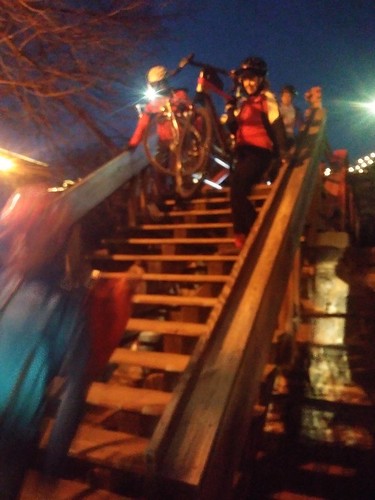
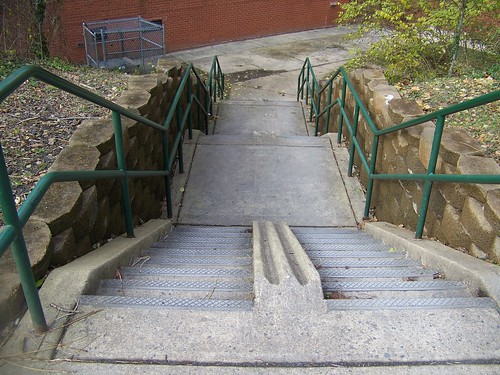
Labels: bicycle and pedestrian planning, micromobility, urban design/placemaking




1 Comments:
Oficjalna strona Casino Lv-bet oferuje turnieje, promocje i kody promocyjne, a także bonus za pierwszy depozyt. - https://top10casinoexpert.pl/casino/lv-bet-casino/
Post a Comment
<< Home